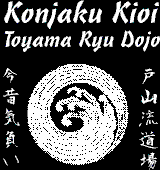 |
Toyama Ryu Batto Do Konjaku Kioi Dojo (Ancient and Modern Fighting Spirit Dojo) |
5980 66th St N Suite M St Petersburg FL 33709 Email: info@toyama-ryu.com Phone: 727-329-9679 |
|
Home
|
Fundamentals (Kihon) 基本Postures (Kamae) 構えKamae are standard guard positions / stances. It is important to keep proper attitude and focus while practicing kamae. They are constantly used in the Toyama Ryu kata and kumitachi. Chūdan no Kamae 中段の構えChudan no Kamae is the middle guard posture with kissaki level with throat. Arms are held forward with a slight bend at the elbow. This is the most common kamae (posture). It is a balance of attack and defense and the most versatile of the kamae.
Seigan no Kamae 正眼の構えSeigan Kamae is a middle guard with point of sword pointed at the opponent’s eyes. The arms are held forward with only a slight bend at the elbow. This is a variation of Chudan no Kamae.
Jōdan no Kamae 上段の構えJōdan no Kamae is a upper guard posture with point of sword pointed up and back. The hands are over the head with the Kashira in the edge of the peripheral vision. This is a very aggressive offensive posture designed to intimidate. It is used in Toyama kata nanahon me and kumitachi happon me.
Migi Jōdan no kamae 右上段の構えOverhead kamae, right foot forward, sword at 45 degree angle, left hand one fist from the forehead. This is a very aggressive offensive posture designed to intimidate.
Hidari Jōdan no kamae 左上段の構えOverhead kamae, left foot forward, sword at 45 degree angle, left hand one fist from the forehead. The left hand is positioned above the left eye, so the tip is slightly to the right, behind the head. This is a very aggressive offensive posture designed to intimidate.
Wakigamae 脇構えWaki no Kamae is a side guard posture with the katana held low at the side with the edge forward. The body is turned at about 45 degrees and the left hand should be in-front of the navel. The length and edge orientation of the katana is hidden from the opponent. Gedan no Kamae 下段の構えGedan no Kamae is a low guard posture with point of sword held at about knee level. It is a defensive position good for deflecting attacks and creating openings. The focus should be on creating a counter-attack. Hassō no Kamae 八双の構えHasso no Kamae is a high guard posture with the katana pointed upwards, the edge forward, and the guard level with the ear. The body is turned at about 45 degrees and the arms should be held in a relaxed position with the elbows pointed slightly downward. This is an offensive position good for a quick attack. Used in Toyama Ryu Kumitachi Gohon Me. Kamae Toku 構え解くKamae with lowered, slightly turned sword (of conquered opponent).
Similar to Gedan no Kamae. Used at the end of Toyama Ryu
Kumitachi. |
Copyright © 2006 by Konjaku Kioi Toyama Ryu Dojo, All rights reserved.
Samurai Swords
Iaito (Practice Swords)
Shinken (Cutting Swords)
Wakizashi (Short Swords)
Tanto (Daggers)
Japanese Weapons
Maintenance
Uniforms
Sharpening
Sword Repair
Martial Arts
Dictionary Your Name in Japanese
Dojo Stories
Tatami Targets
